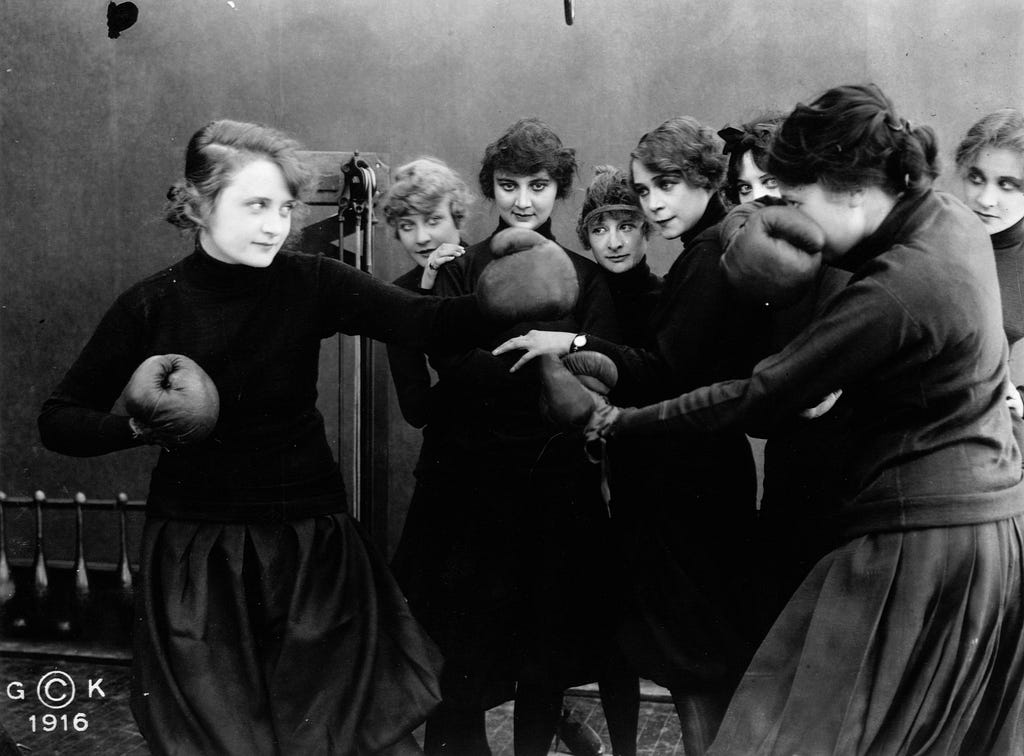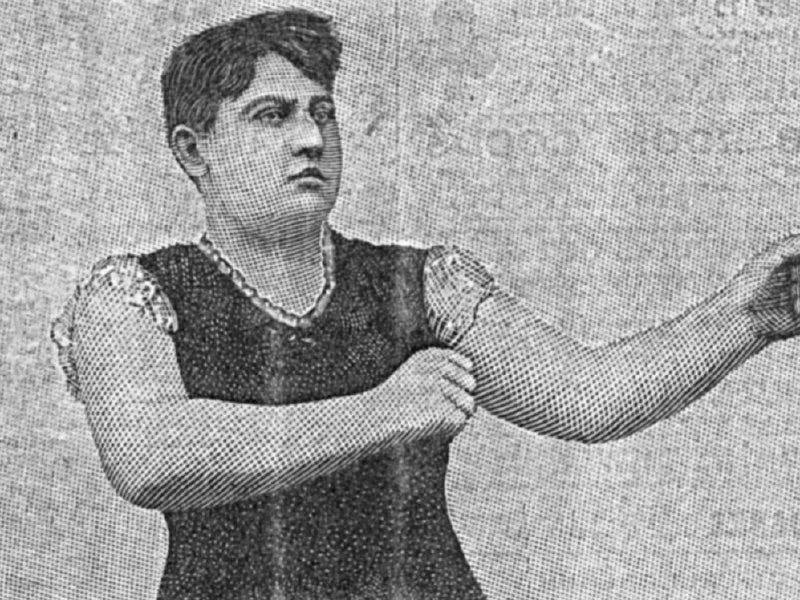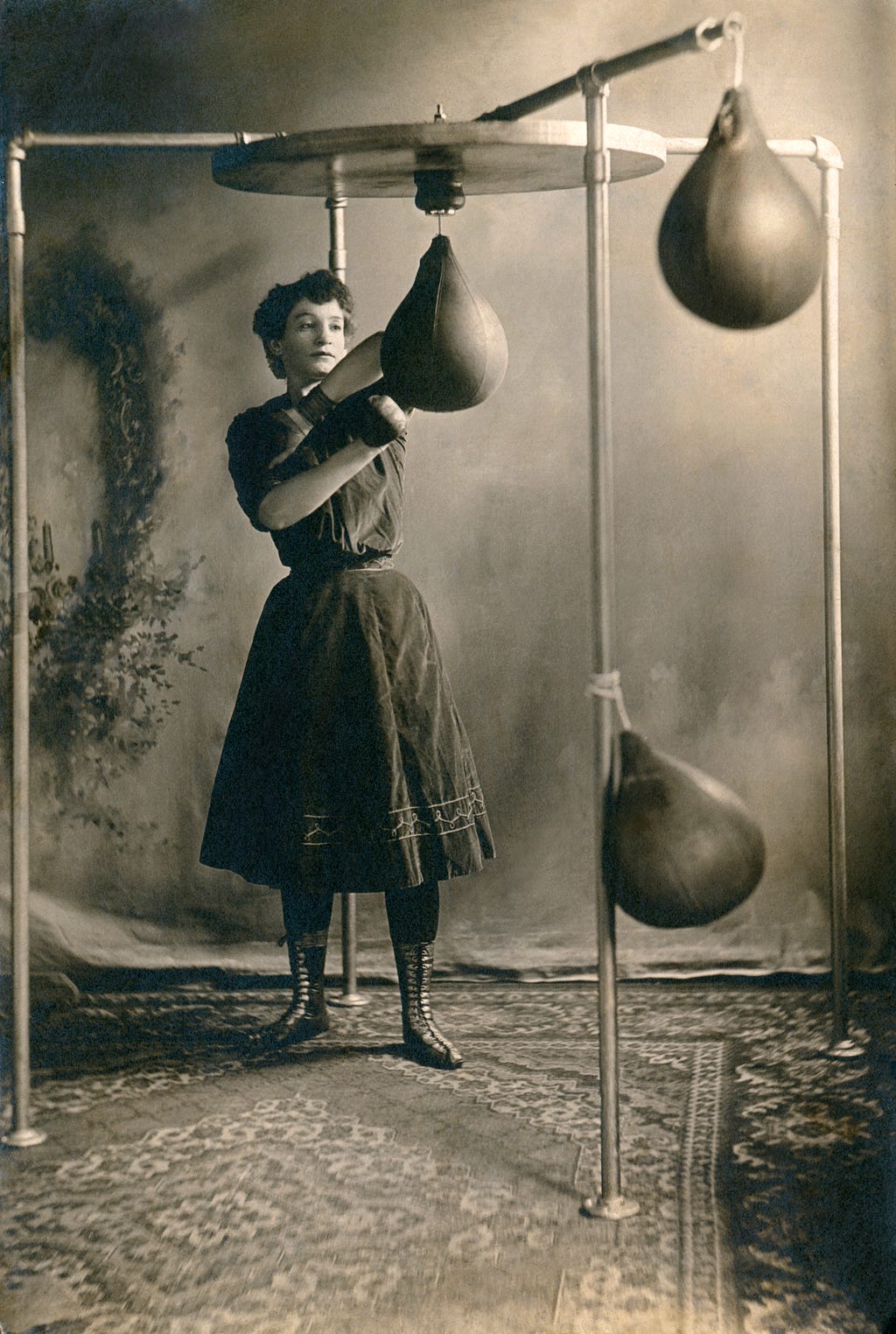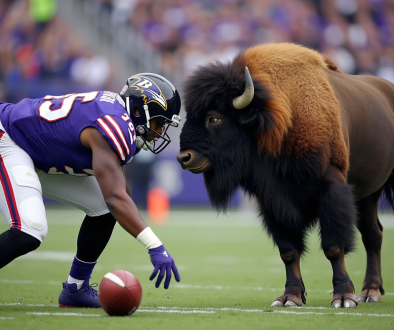For fun and freedom, these 19th century female fighters got in the ring
Meet the women who practiced the “manly art” of boxing

As the 19th century drew to a close, Americans were becoming obsessed with physical fitness, and boxing and other contests of strength were gaining in popularity. Surprisingly — and controversially — some of the most epic bouts were between female fighters.
Cultural anxiety about the nation’s future was one of many factors that gave rise to the national obsession with boxing. The rapid industrialization and urbanization of America had generated worry about changes in daily life. Psychologist G. Stanley Hall and neurologist George M. Beard were concerned that white masculinity had entered a state of crisis. They believed that “excessive civilization” threatened to physically and mentally debilitate men, turning them into effeminate weaklings and ultimately threatening the survival of the race. Anglo-American men also feared the consequences to their own race caused by the rapid influx of new immigrants from southern and eastern Europe, the migration of African Americans to northern communities, and the intermingling of Anglo, Asian, Native American, and Mexican races on the frontier. Rhetoric emphasizing the importance of combating overcivilization and preparing men to take on the task of saving the race and building the nation contributed to the national athletic craze.
President Theodore Roosevelt was an influential advocate of the physical culture movement. Beginning in his youth, Roosevelt aggressively engaged in a variety of active pursuits, including boxing. The purpose, he insisted, was not only to combat his own ill health but also to strengthen his resolve as a man. Roosevelt’s thinking was shaped by the muscular Christianity movement of the 1880s that insisted on the necessity of a strong body to fulfilling one’s Christian duty in civilizing the world. Roosevelt adopted the Victorian definition of manliness that exalted both physical strength and integrity of character. He took it a step further in making a connection between strong manhood and strong nations by insisting that men, like nations, must physically prepare themselves to take on any challenger. These ideas influenced Roosevelt’s later adherence to imperialistic foreign policies.
As the “manly art,” boxing seemed to symbolize Anglo-American masculine toughness. Although the middle and upper classes considered it barbaric, prizefighting had long been associated with masculinity among men of the lower class. As the physical culture movement took hold, more middle-class men began to pursue athletics as a means of better preparing their bodies for their moral duties as husband, father, and citizen. Boxing was revived from its status as a reviled and violent sport of the masses and resurrected as a method of training American men in the courage, integrity, perseverance, and toughness required of “manly” men.
This reconstruction of masculinity paralleled a similar restructuring of femininity. Strict gender boundaries in the mid-nineteenth century confined white middle-and upper-class women to the domestic sphere. These women faced severe societal sanctions that limited the degree and type of their activity. Athletics were viewed as dangerous to the reproductive and emotional health of women. However, by the late nineteenth century, women increasingly pushed the limits of these boundaries by pursuing expanding employment and recreational opportunities in cities across the nation. As physical culture grew in popularity, attitudes toward female athletics also began to change. The New Woman was increasingly expected to be healthy and strong enough to be an effective wife and mother. This was especially important to some eugenicists concerned with protecting Anglo-Americans against race suicide. Athletic training of Anglo men and women was thus seen as essential to the well-being of the nation as a whole. The movement of women into a wide range of sports dismantled old constructions of the frail and weak female, reconstructing her as strong and capable.
Some women seized the opportunity to train in the traditionally exclusively male field of boxing. Hattie Stewart defied notions of the gentle, doll-playing young girl when she explained that as a child she most enjoyed fighting. As a teenager, she channeled her love of active physical play and fighting into boxing. Stewart performed in a number of highly publicized prizefighting matches in the 1880s and 1890s against other female boxers. She also toured the country performing in boxing exhibitions at a range of entertainment venues. Women, like Stewart, who transgressed gender boundaries found themselves the target of critics who directly attacked their femininity.

Opponents of female boxing feared that the athletic woman would develop overly masculine qualities. Their arguments focused on deep-seated concerns about the masculine nature of boxing and its potential to defeminize women and disrupt the “natural order.” The public expressed simultaneous amusement and hostility toward female boxers, and promoters discriminated against female boxers at the same time they exploited them to earn a profit. Meanwhile, the press tended to celebrate the physical accomplishments of the male boxer while constructing female fighters as physical freaks. Matches between women were described as “disgraceful,” “barbaric,” “savage,” “loathsome,” “brutal,” and “disgusting.” Female boxers were frequently depicted as animalistic or grotesquely deformed masculine deviants.
Some female boxers chose to emphasize their femininity in response to criticisms about the masculinizing effects of boxing. When interviewed about their practice of the sport, these women chose to talk about their roles as wives and homemakers to minimize the association with masculinity. Boxing instructors also responded to the apprehension caused by women’s boxing by creating a less aggressive and less combative type of boxing that focused more on weight loss and the development of strength allowing women to retain their so-called feminine qualities. This lighter, feminized version of boxing was marketed directly to this middle-and upper-class audience of white society women. Ultimately, this less aggressive form of women’s boxing was tolerated by the general public, if only as a means of strengthening Anglo women’s bodies for their role as wives, mothers, and civilizers.
Other women rejected the gendered restrictions on the extent of their physicality and continued to pursue competitive boxing, directly defying their critics. Working-class women found a degree of fame and social mobility in exhibition boxing, and some even pursued careers in competitive prizefighting. Gussie Freeman was raised in a poor German immigrant family on Long Island, New York. She found employment at the age of twelve making rope at a ropewalk, where the intense physical labor required a great deal of strength and endurance. Freeman began her boxing career when her coworkers encouraged her to take on the challenge of professional boxer Hattie Leslie who offered twenty-five dollars to any fighter who could knock her out in four rounds. Freeman lost the fight to Leslie but won an opportunity to go on tour with Leslie as a sparring partner. Freeman gave up work on the ropewalk and went on tour around the country, performing in a number of boxing matches. Her socioeconomic status and lack of education limited her employment opportunities, but boxing offered her a glimmer of hope. After a year on tour, however, she returned home feeling disillusioned and cheated out of her salary. Freeman and other female boxers who were put on “exhibition” in this way also felt devalued as professional boxers. Spectators and promoters essentially reduced these women to a commodity to be bought and sold as entertainment.

Regardless of social class, women who took up some variation of boxing overwhelmingly expressed the sense of liberation they felt through boxing. However, as Freeman’s story reveals this freedom was limited. The creation of feminized versions of boxing fitness classes for the middle and upper classes, while paving the way for women to train in the fighting arts, ironically also played into existing gender stereotypes about women’s allegedly frailer physical natures. Even as female boxers developed the technical skills and physical abilities of male pugilists and proved their equality as athletes, they still failed to dismantle the hegemonic gender structure. Female competition fighters faced a wide range of discrimination in trying to penetrate the male world of boxing. Often trivialized as mere physical freaks or as sexualized objects of exhibition, female competitive boxers struggled to be taken seriously. Exhibition fighters showcased their physical talents and skills but often acquiesced to demands that they flaunt their sexuality for popular attention and economic gain. Female competition fighters discovered that the establishment profited off their ability to draw curious crowds of paying spectators but failed to take them seriously as fighters.
In the end, then, the pursuit of the manly art provided an avenue for the New Woman to test the limits of her gender and dismantle existing stereotypes, although the contradictory results of her endeavor reveal the limits to her being viewed as an equal in male sporting culture. Ultimately, many female boxers would find a variety of alternative meanings in their pursuit of the fighting arts, from the political to the personal.
Read more about the pioneering women who studied boxing and self-defense in Wendy Rouse’s, Her Own Hero: The Origins of the Women’s Self-Defense Movement from New York University Press. https://nyupress.org/books/9781479828531/
For fun and freedom, these 19th century female fighters got in the ring was originally published in Timeline on Medium, where people are continuing the conversation by highlighting and responding to this story.
Powered by WPeMatico


